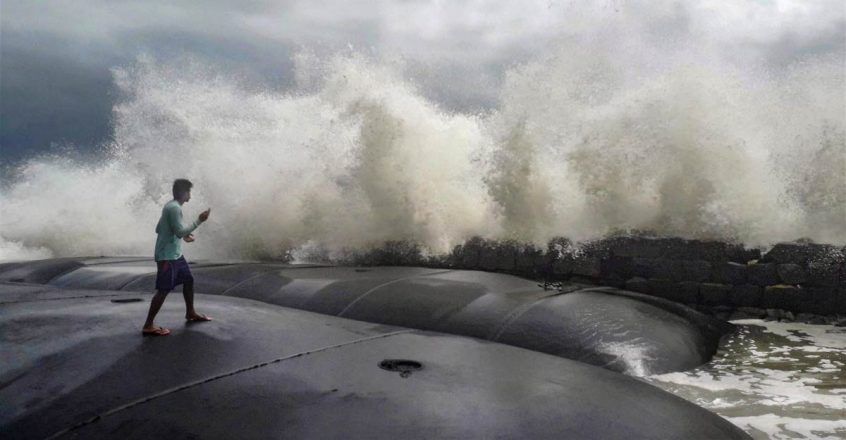
Aila, Amphan, Asani: Who names tropical cyclones and why?
Every time the weathermen forecast a cyclone, the storm comes with a name, usually unique and indigenous, causing intrigue among many about what and who is behind the christening. With Cyclone Asani – a name given by Sri Lanka that means wrath in Sinhalese – formed in the Bay of Bengal on Sunday morning and hurtling towards the east coast, the same question has come to bog us again.

Every time the weathermen forecast a cyclone, the storm comes with a name, usually unique and indigenous, causing intrigue among many about what and who is behind the christening. With Cyclone Asani – a name given by Sri Lanka that means wrath in Sinhalese – formed in the Bay of Bengal on Sunday morning and hurtling towards the east coast, the same question has come to bog us again.
Why are cyclones named?
According to the World Meteorological Organisation (WMO), an agency under the United Nations, there can be more than one cyclone at a time in a particular geographical location or around the globe and the systems can last for a week or more. Therefore, each tropical storm is given a name to avoid confusion, facilitating disaster risk awareness, management and mitigation.
The concerned Regional Specialised Meteorological Centres (RSMCs) or Tropical Cyclone Warning Systems (TCWSs), are entrusted with naming the tropical cyclones forming over different ocean basins. There are six RSMCs worldwide and five regional TCWSs.

The India Meteorological Department (IMD), the RSMC in New Delhi, uses a standard procedure to christen tropical cyclones brewing in the north Indian Ocean that covers the Bay of Bengal and the Arabian Sea.
Tropical cyclones started assuming names only after 2000, the year when the WMO/ESCAP panel on tropical cyclones decided to do so at its 27th Session held in 2000 in Muscat. The naming of cyclones by eight participant countries – India, Bangladesh, Maldives, Myanmar, Oman, Pakistan, Sri Lanka and Thailand – began from September 2004 onwards.
The IMD usually names a cyclone that forms over the northern Indian Ocean when they have reached a maximum sustained surface wind speed of 62 kmph or more.
How are the names chosen?
Short and easy-to-pronounce names are helpful in rapidly and effectively disseminating detailed storm information between hundreds of scattered stations, coastal bases and ships at sea. It is less subject to error than the older and more cumbersome latitude-longitude identification methods. Since 1953, Atlantic tropical storms have been named from lists prepared by the National Hurricane Center in the US. In the beginning, storms were named arbitrarily.
Also read: Cyclone Asani to bring heavy rain to Andhra, Bengal, Odisha from Tuesday: IMD
From the mid-1900s, feminine names began to be used for storms. Meteorologists decided later to name storms from a list for a more organised and efficient system, the WMO stated in its website.
While suggesting names, countries have to ensure that the name is gender neutral and doesn’t refer to politics or clash with names of political figures, religious beliefs and cultures. The word, which can have a maximum of eight letters, should not be offensive to any member country or hurt the sentiments of any group of population. While the panel reserves the right to reject the proposed names, the finalised names may also be reviewed during the course of time of implementation with the approval of the PTC in its annual session in case a member country raises an objection.
The name of a storm from the South China Sea that crosses Thailand and emerges into the Bay of Bengal will not be changed. Once a name is used, it will not be repeated again.
The next cyclone has a name already
Interestingly, cyclones are not named as they happen. The names have already been chosen beforehand – the next cyclone after Asani will be called Sitrang, a name given by Thailand.
In 2020, a new list was released with 169 names, including 13 names each from 13 countries. Earlier, eight countries had given 64 designations. Names from India that have been used include Gati (speed), Megh (cloud), Akash (sky). Other designations that have been used earlier included Ogni, Helen and Fani from Bangladesh; and Laila, Nargis and Bulbul from Pakistan. The names that will be used in the future include the likes of Ghurni, Probaho, Jhar and Murasu from India, Biparjoy (Bangladesh), Asif (Saudi Arabia), Diksam (Yemen) and Toofan (Iran) and Shakhti (Sri Lanka).
(With inputs from agencies)


